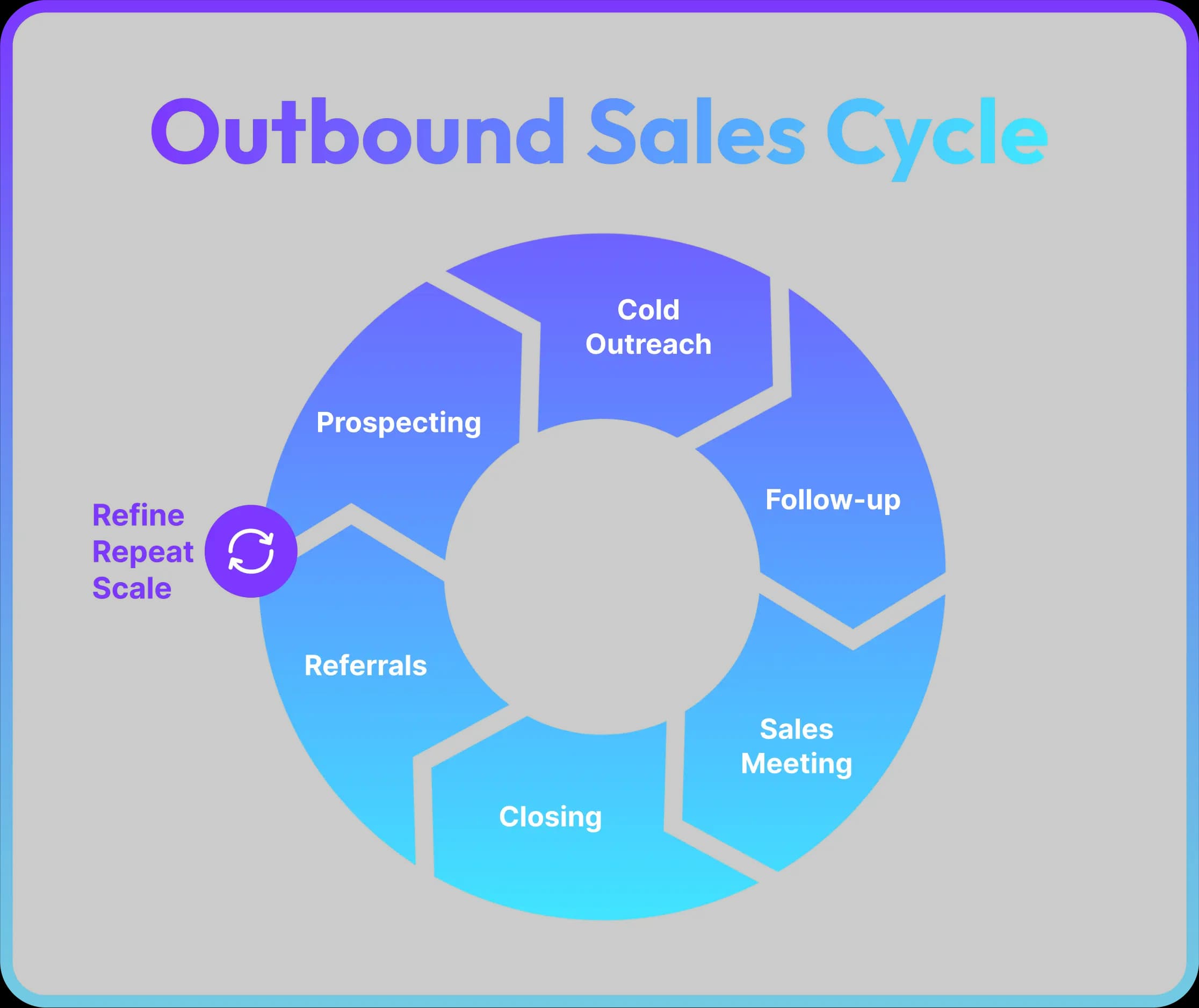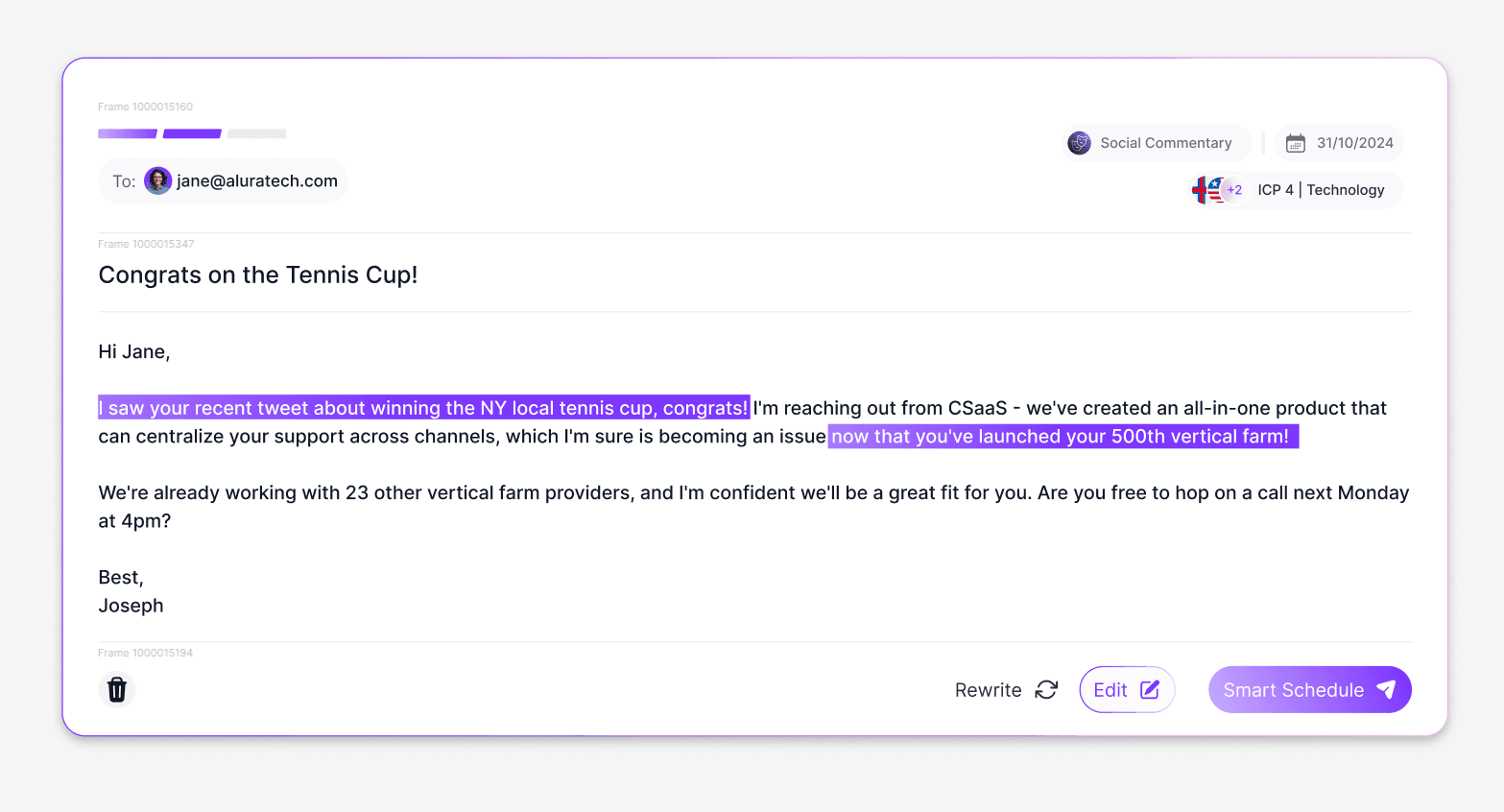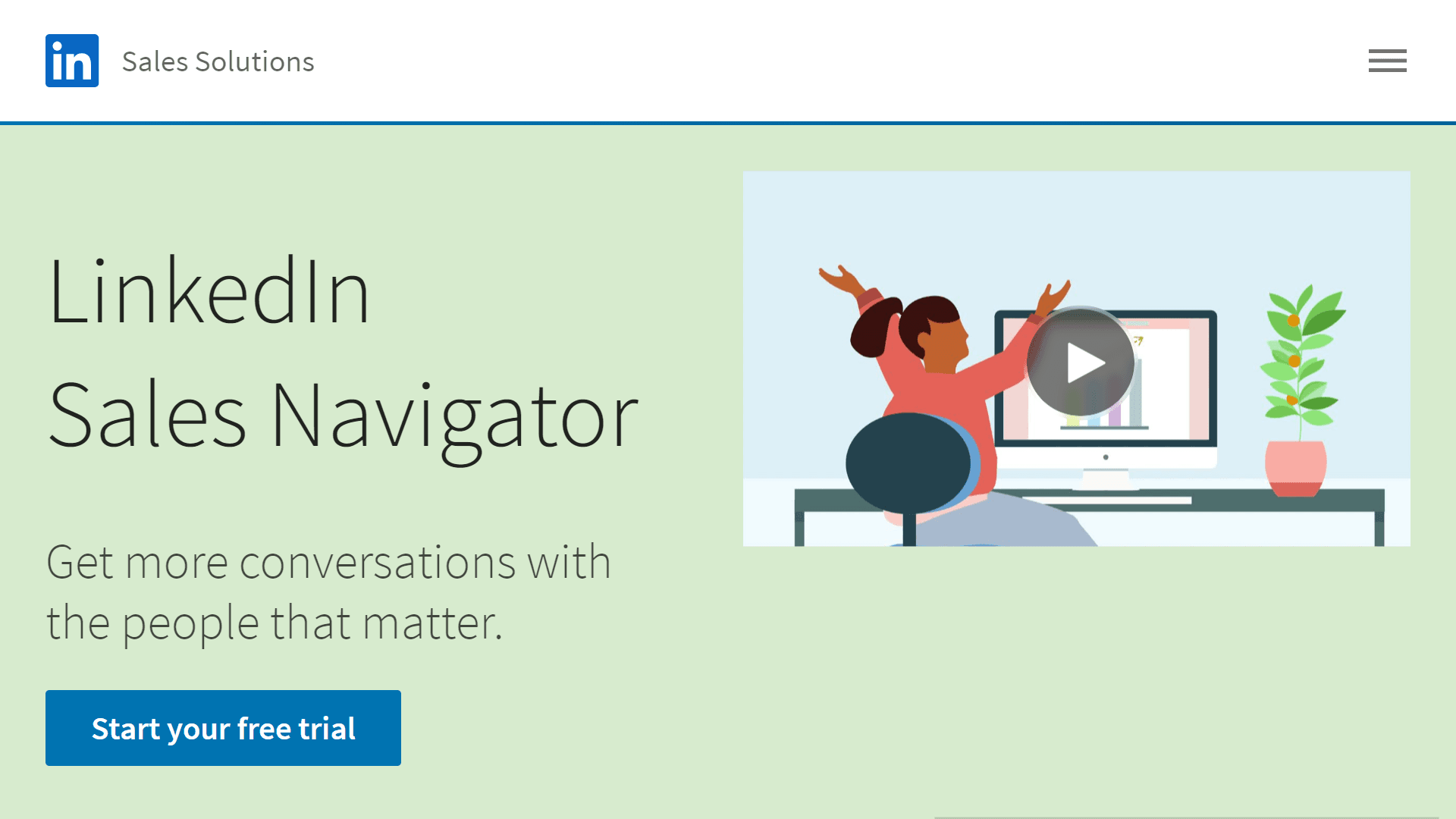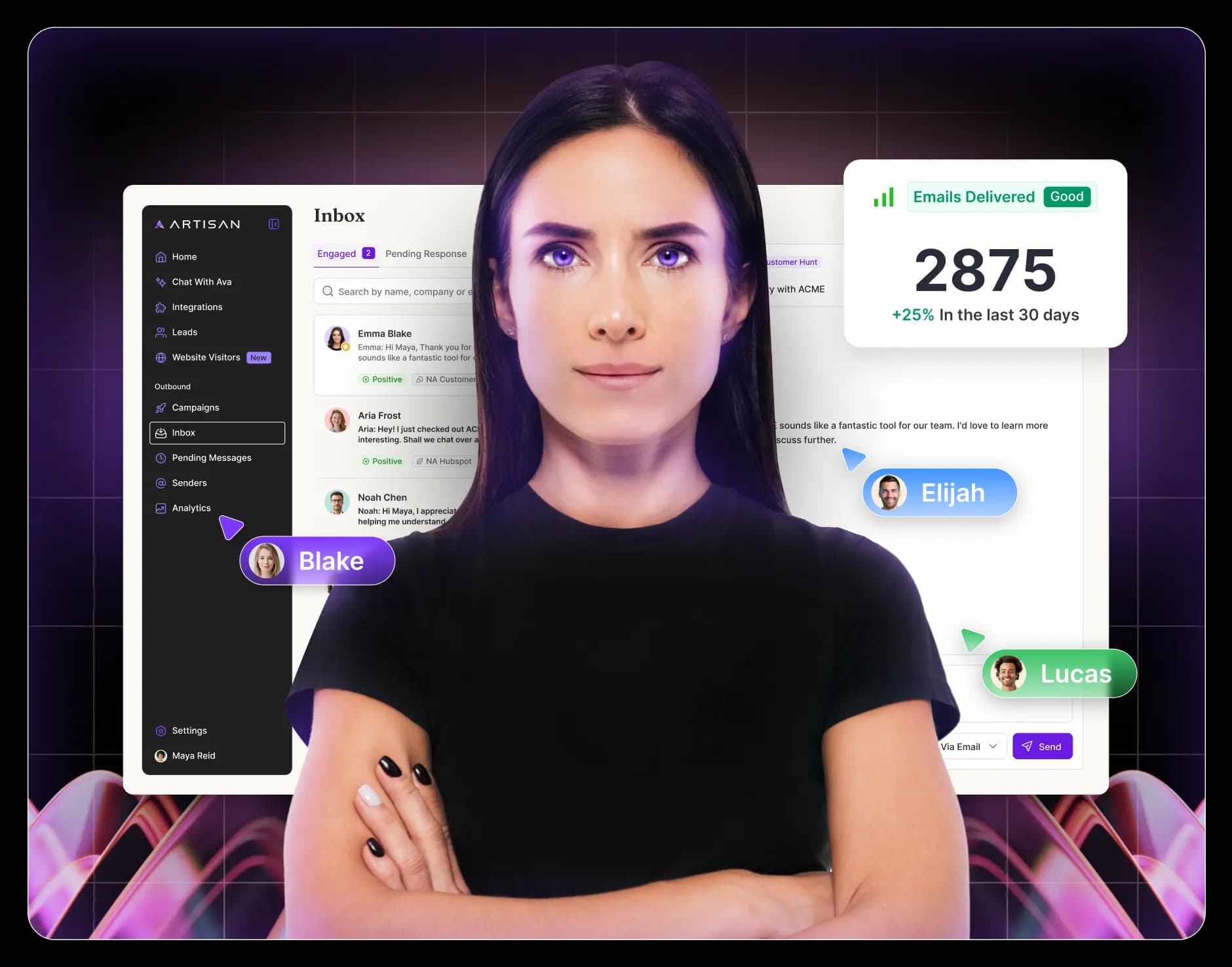🎉
We've raised a $25M Series A. Read more
How To Build An Outbound Sales Team In 2025

Outbound sales is controversial. There’s no shortage of experts making proclamations like “outbound sales is broken,” “outbound sales sucks,” and even “outbound sales is dead”—all real titles from the web.
It’s easy to dismiss these claims as noise-making clickbait. But the reality is more complex. There’s no doubt that outbound sales still works—according to published benchmarks, typical SDRs secure 12 monthly meetings and the average sales win rate across all industries is 47%.
Yet many industry veterans maintain that outbound sales is on borrowed time. Look at your own experience as an example. When did you last purchase a product after a cold call? Or reply to an email pitch? Or book a meeting off the back of a LinkedIn message?
So is outbound sales on its way to the grave? We think the answer to that question is a definite no. But what worked back in the 80s in the days of door-to-door sales doesn’t work today.
Instead, successful outbound sales in 2025 demands a mix of hyper-personalisation, automation with the very latest tools (yep, we’re talking AI), optimal data health, and collaborative teams capable of giving campaigns the human touch.
With that in mind, let’s take a look at how to build a winning outbound sales team.
What Is Outbound Sales and What Roles Are Involved?
Outbound sales is the process of engaging and selling to prospects who have not actively reached out to you and may not be aware of your brand. Cold calling and email are two of the best-known examples. Outbound sales contrasts with inbound sales, where prospects initiate a relationship with your business.
Generally speaking, outbound sales teams contain three main roles:
Business development representatives (BDRs) are responsible for outbound prospecting. They find the leads that SDRs then qualify and engage.
Sales development representatives (SDRs) are top-of-the-funnel salespeople. They’re responsible for initiating contact with cold leads who have never come across your company to build relationships.
Account executives (AEs) are closers tasked with sealing the deal. They tend to be experienced salespeople with strong deal-making skills. Top performing AEs often have win rates—the total number of won deals out of all meetings taken—of 70% and above, in contrast to the industry average of about 45%.
Because outbound sales teams are responsible for all stages of the lead-generation and nurturing process, they tend not to work as closely with the marketing department as inbound sales teams.

Defining Your Outbound Sales Strategy Before Hiring
Before launching into building your team, it’s important to have a high-level understanding of what your outbound sales process will look like.
This isn’t about filling in the specifics of your workflow. The aim is to identify key components of your process to help you hire people with the right experience, training, and past results.
Identifying your target market and ideal customer profile (ICP)
It all starts with your ICP. Or, rather, your ICPs plural. One is rarely enough. Having ICPs for the various segments of your market allows you to filter candidates for your team based on industry experience.
Here are the main data points to include in your ideal customer profiles:
Industry
Sub–industries
Location
Budget
Employee count
Technology stack
Title of contact (CEO, CTO, Sales Director, etc.)
In addition to these specific attributes, you should also describe pain points and benefits. What specific struggles are your prospects experiencing and what benefits are they actively looking for?

Developing an effective outbound sales strategy
Outbound sales roughly spits into three categories: prospecting, nurturing, and closing. These broad tasks align with the roles of BDR, SDR, and AE.
When you understand how each of these works in regards to your market, you can better ascertain whether potential team members will be able to hit—and ideally exceed—your targets.
Here are three core questions to ask when developing your outbound strategy:
Where will the leads come from? What are the best lead databases, scraping practices, third-party services, and social media platforms for your industry?
What type of nurturing strategies work in your market? What are the best strategies for connecting with buyers or buying teams potentially interested in your services?
What does the closing process look like? Do your prospects prefer in-depth presentations, results-based guarantees, long-term commitments, trial periods, or another approach?
Aligning with the overall sales process and sales strategy
Outbound sales will only form one part of your company’s overall sales strategy. It may be the biggest generator of revenue, but it is one part nonetheless.
Aligning with the overall sales process—inbound and outbound—involves placing your outbound sales strategy in a broader context.
For example, will SDRs be required to nurture inbound leads in addition to cold leads? Will BDRs work with marketing to tailor brand awareness campaigns? Will AEs be expected to engage with existing clients to drive referrals?
If your sales team will work in a siloed fashion, that’s one thing. But if there will be overlap with other departments, these skills will need to be accounted for in the hiring process.
Recruiting and Onboarding Sales Development Representatives (SDRs) and Account Executives (AEs)
Once you know what your sales process will look like, you can start advertising for the right people and filtering them based on your criteria.
Key traits to look for in BDRs, SDRs, and AEs
Here are the top three traits that make an SDR stand apart:
Experience. Do candidates have industry-specific outbound sales experience? Are they familiar with working with prospects that fit your ICPs? Have they got a track record of closing deals with key decision-makers?
Trainability. If you’re hiring early-career salespeople, ensure they’re open to learning and intend to stay with you for at least 24 months.
Results-focused. In outbound sales, “results-focused” is more than a tired resume cliche. It refers to whether or not candidates understand they need to meet definite targets for new opportunities generated, sales-qualified leads (SQLs), and closed-won deals. Experienced candidates should be able to present a proven track record.
Tech savvy: Over-reliance on legacy software closes off opportunities to automate and streamline important parts of the sales process, including lead filtering, personalization, outreach optimization, and analytics. Knowing how to use modern tools—especially AI-driven ones—is a must for outbound prospecting and outreach in 2025.
Best practices for onboarding new team members
Successful onboarding can dramatically cut down the time it takes to maximize the performance of new hires.
Here are three practical suggestions for quickly onboarding new team members:
Allocate a systems champion. Appoint somebody who can train salespeople to use your tech stack and troubleshoot any lingering issues.
Set up a mentorship or shadowing program. Mentoring is one of the best ways for experienced team members to pass on their skills to new hires.
Build onboarding training with current team members. When creating your onboarding program, consult with current team members to identify areas of inefficiency to address in initial training.
Training programs to optimize performance
Ongoing training keeps your team up to date with best practices, irons out inefficiencies, and helps overcome emerging obstacles.
A rigorous training program is one of the surest ways to continuously, steadily nudge up your performance metrics, with companies that invest in training reporting a 200% uplift in performance.
A sales training program should:
Include hands-on practice
Focus on specific results (like improving SQLs or won deals)
Conduct preliminary performance assessments to identify growth areas
Tailor training to specific roles (BDR, SDR, AE)
Use team member feedback to improve future sessions
Notably, training is one area where outsourcing can be a cost-effective strategy. Many training companies spend

Setting Up Your Sales Process
Setting up your sales process involves defining the specific stages and allocating the right people. When everybody involved clearly understands the remit of their responsibilities, performance will be optimal.
Designing a structured outbound sales process
A standard outbound sales process has six stages:
Prospecting. This involves putting together a list of leads from databases, web scraping, early-stage MQL leads, and sometimes third-party services. It is the job of the business development representative (BDR).
Cold outreach. Early-stage outreach involves sending cold emails, social media messages, and making calls. It is the job of the sales development representative (SDR).
Follow-up: Sending just one follow-up email increases reply rates by 49%. SDRs are responsible for follow-up outreach.
Sales meeting: Once a meeting is booked, account executives (AEs) typically take over and conduct a sales meeting, which may take the form of a pitch, demo, question-and-answer session or, in some cases, a more informal discussion
Closing: AEs won’t always close a deal on the first meeting. Especially for high-value B2B products with multiple decision-makers in the buying process, AEs may hold multiple meetings before closing.
Referrals: Once a deal is closed, AEs often pursue referrals where appropriate as they tend to have high conversion rates.

Importance of lead generation and qualifying leads
If there’s one thing that can take an outbound sales campaign from good to excellent, it's qualification. SDRs are responsible for qualifying leads before passing them onto AEs, and your overall win rate depends directly on the quality of qualified leads.
Qualification criteria include the following:
Lead magnet downloads (for example, a white paper)
Email opens and clicks
Information requests
Social media interactions
Company funding rounds
Media announcements
Crafting effective messaging for outreach and follow-up
To craft hard-hitting outreach messages, follow these tips:
Ditch “I hope this email finds you well” and open with a specific, personalized line.
Keep the description of your services concise and targeted.
Mention specific results you’ve achieved for similar clients.
Include a call-to-action at the end with a definite time.
Here's an example written by Artisan’s AI SDR Ava that automatically includes all these elements:

Ready to find and reach out to B2B leads on autopilot? Ava, Artisan’s AI SDR, will fill your sales pipeline on autopilot. She will identify best-fit leads from the 300 million-strong Artisan database, send highly personalized outreach, and follow up at the relevant time. Get in touch for a free demo now.
How to Scale Your Sales Team
At some point, you will likely be faced with the prospect of growing your sales team. When this happens, a few straightforward pointers can help you navigate the process with ease.
Building an in-house team vs. outsourcing outbound sales
If you’re torn between scaling your in-house team or outsourcing to an agency, we have a straightforward piece of advice: keep it in-house.
Here are four reasons why in-house outbound teams tend to perform better:
Account executives and SDRs are likely to have the deep understanding of your products and services necessary to overcome prospect objections.
Team members working in-house are better placed to understand your workflows and offer feedback to improve them.
Training and enrichment are controlled by you, enabling you to direct the development of sales reps.
Cost and efficiency gains will improve your profitability, not the outsourcing company’s.
Create a playbook for consistent performance
A sales playbook is a document that outlines your processes, best practices, and templates. Playbooks are dynamic, regularly-updated documents. They’re essential for successfully scaling because they create a standard framework in which sales reps can work.
Strategies for cost-effectively scaling your outbound efforts in B2B sales
When expanding your sales team, keep the following tips in mind to manage spiraling costs:
Automate time-consuming manual processes. Automating simple human processes that take a lot of time is one of the easiest ways to cut costs. Searching for automation opportunities should be an ongoing process and team feedback is one of the best ways of pinpointing inefficiencies.
Cut out low-value activities. Many tasks will deliver comparatively lower returns. Identify these and retarget resources on higher-value tasks. For example, SDRs could be targeting saturated markets, contacting buyers with existing solutions from competitors, or going after companies with small revenue.
Keep your focus on lead health. As BDRs expand prospecting efforts, lead health can suffer, with negative and costly effects right through the sales cycle. As you scale, ensure that you maintain stringent filtering criteria.
Using AI BDRs and SDRs to Enhance Your Sales Efforts
AI BDRs and SDRs represent the next generation of outbound sales technology and are already boosting outcomes for companies, freeing human reps to focus on nurturing and closing.
What are AI BDRs and what’s their role in outbound sales?
AI BDRs and SDRs are virtual AI sales professionals capable of handling all aspects of outbound sales right up to the meeting stage, where an account executive takes over. Unlike traditional automation, AI BDRs/SDRs can complete more complex human tasks.
One example of an AI BDR/SDR is Ava, a virtual AI assistant available through the Artisan platform. She is typical of modern AI technology and can work fully autonomously, with minimal to zero human input required.
Ava can run the following parts of an outbound sales campaign:
ICP creation
Prospecting
Email warmup
Personalized outreach
Outreach optimization

Want to see Artisan in action, finding and contacting leads for your company? Get in touch for a free demo now.
Benefits of integrating AI BDRs into your sales team
AI BDRs have three core benefits that make them an excellent addition to traditional sales teams:
Cost: AI BDRs have no additional costs on top of the monthly software fees.
Speed: Outreach happens on autopilot 24 hours a day with hundreds or even thousands of emails sent every hour.
Reach: AI BDRs can filter vast amounts of data and pick best-fit leads from databases with hundreds of millions of prospects.
Top 5 Tools and Technologies for Outbound Sales
Here are the tools that we consider absolutely essential for turning potential customers into loyal, happy fans.
1. Artisan for Outbound Sales Automation

Artisan is a next-gen AI-based outbound sales platform. Unlike many competitors, Artisan has built AI right into the core functionality of the platform and it’s much more than a nice add-on.
Artisan’s BDR and SDR, Ava, can handle everything from lead prospecting (with access to a 300 million-strong database) to lead follow-up. Ava will also analyze results and run automated optimization on your campaigns.
Features
Database of 300 million B2B leads with up-to-date ICP data
Full outbound sales automation across prospecting, outreach ,and campaign optimization
Personalization based on multiple data sources at all stages of the lead nurturing process
AI playbooks that replicate campaigns with historical success
Email warmup and deliverability optimization
Pricing
Artisan works on a custom pricing model so customers can get the best possible price for their requirements. Contact a sales representative to arrange a demo.
2. Zoho CRM for Customer Relationship Management

A customer relationship management (CRM) platform acts as a central location for storing lead contact information and tracking their sales status. Zoho CRM is an easy-to-use option with solid functionality.
Features
Storage of lead contact data
Sales status
Forecasting tools
Pipeline tracking
Large integrations library
Pricing
Plans start at $14/month per user and go up to $40/month per user.
3. LinkedIn Sales Navigator for Manual Prospecting

LinkedIn Sales Navigator is a must-have for B2B outbound sales teams, even if they’re using other databases to prospect for leads. At around 800 million leads, it’s one of the largest databases in the world and the data is of a very high quality.
Features
Up-to-date database of B2B leads
ICP filtering options
Direct private messages (InMails)
Pricing
Plans start at $99/month with big discounts if paid annually.
4. Calendly for Booking Meetings

Calendly fills a small but necessary purpose for outbound sales: scheduling meetings. There are many providers of appointment scheduling software, but Calendly is one of the easiest to use and most well-known.
Features
Appointment booking
Calendar integrations
Automated reminders
Pricing
Pricing starts at $10/month per user. It has a good free plan.
5. RingCentral for International Calls

Ringcentral allows SDRs to make international calls and offers additional tools, such as analytics and recording, for optimizing sales processes.
Features
International numbers and call packages
Call recording
High-definition voice
Pricing
Plans start at $30/month per user but costs will vary based on how many international numbers and minutes your team requires.
Winning at Outbound in 2025
Winning at sales in 2025 is about finding a just-right mix of tech efficiency and human magic.
It’s true that competition has never been fiercer, with many buyers jaded at an endless assault of cold pitches.
However, this creates a unique opportunity for companies willing to do things differently. A well-trained, experienced, and innovative team that draws on the very latest best practices and cutting-edge tech is a rare and valuable thing.
But with the right approach, there’s no reason why your business can’t have one.
Experience cutting-edge sales automation firsthand. Hire AI SDR Ava now, and she’ll launch an outbound sales campaign in minutes, with a focus on high-quality leads and personalization that matches human outreach.
Author:
Tina Sang
You might also like

Ready to Hire Ava and Supercharge Your Team?
Ava is equipped with the best-in-class outbound tools to automate your outbound, freeing your reps’ time to focus on closing deals.